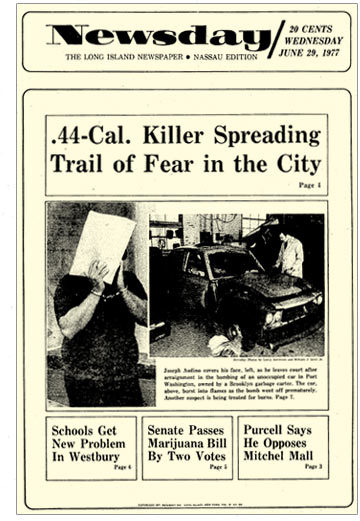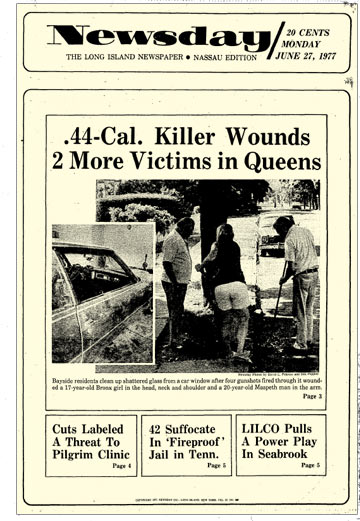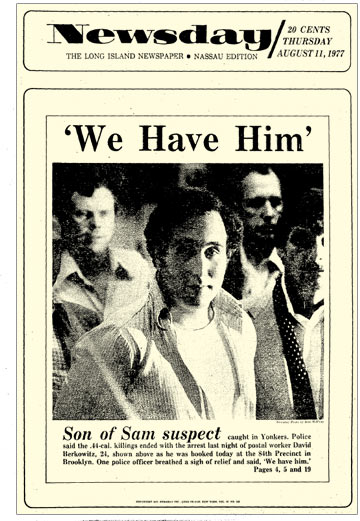Forty years ago, the capture of David Berkowitz — better known as Son of Sam — put an end to a series of killings that left six people dead and terrified New York City for more than a year.
His seemingly random attacks on young women and couples meeting in the city’s lovers’ lanes prompted people to stay indoors and women with long hair — reputedly the killer’s prime targets — to cut their hair short.
The hunt for Berkowitz, first dubbed by the media as the “.44-caliber killer” due to his weapon of choice, was at the time the most dramatic in the city’s history and the largest in scope.
In an article about Berkowitz’s Aug. 10 capture, Newsday wrote: “In the year’s time that Sam terrorized the city, New Yorkers lived with fear and a feeling of helplessness generated by a man who killed people he did not know for reasons normal persons could not understand.”
Here’s a look back at the case:
Who he was
David Berkowitz was a 24-year-old postal worker living in Yonkers when he committed the deadly attacks across the city.
Berkowitz, born Richard David Falco in Brooklyn, was adopted when just a few days old by Pearl and Nathan Berkowitz, a couple who lived in the Bronx.
He joined the Army when he turned 18 in 1971 and served for three years.
After committing a double murder in Pelham Bay Park on April 17, 1977, Berkowitz left a handwritten note addressed to the Queens homicide commander, Capt. Joseph Borelli, in which he identified himself as Son of Sam.
Ten days later, Chief of Detectives John L. Keenan replied to the killer at a press conference: “Son of Sam: We now know you are not a woman hater — and know how you have suffered. We wish to help you and it is not too late. Please let us help you.”
On June 1, Berkowitz also wrote to New York Daily News columnist Jimmy Breslin.
“Tell me Jim, what will you have for July twenty-ninth?” the killer wrote to Breslin, referencing the anniversary of the first in his string of shootings. “You can forget about me if you like because I don’t care for publicity. However, you must not forget Donna Lauria and you cannot let the people forget her either. She was a very sweet girl, but Sam’s thirsty lad and he won’t let me stop killing until he gets his fill of blood.”
From the summer of 1976 until his capture in August of the following year, Berkowitz killed six people and wounded seven with a .44-caliber revolver in eight incidents spread across Queens, Brooklyn and the Bronx.
Berkowitz also claimed to have set about 2,000 fires in the city since 1974.
July 29, 1976:
No one saw the gunman and detectives were stumped for a motive. The only clue was the relatively rare .44-caliber bullets used by the shooter.
Oct. 23, 1976:
Rosemary Keenan, 21, and her date, Carl DeNaro, 20, were sitting in a parked car about 1:30 a.m. on 160th Street in Flushing, Queens, when Berkowitz opened fire with a .44-caliber revolver from the passenger side.
Keenan was uninjured. DeNaro had a metal plate put in his head and suffered permanent damage to his right middle finger.
Nov. 27, 1976:
Joanne Lomino, 18, and Donna DeMasi, 17, were returning from a night out when they stopped to talk in front of Lomino’s home on 262nd Street in Bellerose, Queens. About 12:40 a.m., Berkowitz approached them and fired five shots. DeMasi was shot in the neck. Lomino was shot in the back and paralyzed.
The victims were the first to be able to provide a description of Berkowitz from which a police artist produced a sketch of the killer. Jan. 30, 1977
Christine Freund, 26, was killed while sitting in a parked car with her boyfriend, John Diel, 30. Freund and Diel had gone to see a showing of “Rocky” and then to dinner. They were in Diel’s car when Berkowitz fired three shots from a short distance.
Two bullets struck Freund, who died four hours later at St. John’s Hospital in Elmhurst. Diel was uninjured.
March 8, 1977:
Berkowitz shot and killed Virginia Voskerichian, 20, while she was walking to her home from the subway station at Continental Avenue in Forest Hills — half a block from where Freund was murdered five weeks earlier.
The Voskerichian murder was different from the other shootings, police said at the time. It was far riskier, at the tail end of the rush hour and only a few yards around the corner from the busy Continental Avenue shopping district. The victim was walking, not stationary, and she was alone, not with a companion.
“I think he was trying to throw us off with that one, coming right back almost to the exact spot,” a task force detective told a Newsday reporter following the shooting.
April 17, 1977:
Berkowitz shot and killed Valentina Suriani, 18, and Alexander Esau, 20, while they were seated in a car parked at Pelham Bay Park at 3 a.m.
June 26, 1977:
Judy Placido, 17, and San Lupo, 20, met at a discothèque in Bayside, Queens, and left together about five hours later. They were seated in a car about a block away from the club when Berkowitz fired on them.
Placido was shot across the right temple, in the neck and right shoulder. Lupo was shot in the arm.
July 31, 1977:
Stacy Moskowitz and Robert Violante, both 20, were on their first date. The couple sat in a car parked across from a playground in Bath Beach, Brooklyn. Witnesses saw Berkowitz approach the vehicle and fire his revolver.
A bullet destroyed Violante’s left eye and severely damaged his right eye. Moskowitz was killed.
On the night of the last attack, a woman in the Bath Beach area told police she was approached by a man holding an object and that parking tickets were being issued nearby at the time.
Berkowitz received a ticket for parking his yellow Ford Galaxie near a fire hydrant about an hour before shooting Moskowitz and Violante, allowing police to trace him back to his Yonkers apartment.
Officers converged on his building at 35 Pine St. on the night of Aug. 10. A loaded submachine gun and a letter addressed to Suffolk County police containing a map of Long Island recreation areas were found in Berkowitz’s car. City officials had speculated Berkowitz was planning a massive assault with the submachine gun on one of Long Island’s beaches, Newsday reported.
Police surrounded Berkowitz at about 10 p.m. as he walked out of his building.
Berkowtiz, who was carrying the .44-caliber revolver he had used in his killing spree, was booked in Yonkers on gun charges and then escorted to police headquarters in downtown Manhattan.
Berkowitz initially told psychiatrists that “demons” spoke to him through a dog belonging to a Yonkers neighbor named Sam Carr and ordered him to kill “neat, clean and well-groomed” young people.
However, Berkowitz later said he made the story up as a way of justifying the attacks, he told a Newsday reporter during an interview at the Attica Correctional Facility.
“You see, in about the first four or five shootings, I didn’t have this idea about demons in my mind,” Berkowitz said. “It wasn’t till later on, I think about the fifth shooting, that I left a note at the scene saying why I was doing this. But I knew this wasn’t really true. I just had to convince myself. I couldn’t accept the fact that I was doing this out of my own volition. So I just conjured up and invented the idea of some type of demonic army and of being possessed.”
After a debate about whether Berkowitz was mentally capable of standing trial, he pleaded guilty on May 8, 1978, to all of the shootings.
Two weeks later, at sentencing, Berkowitz attempted to jump out of a courthouse window, but was restrained. As he was led into the courtroom, he taunted the family of his last victim, Stacy Moskowitz, by chanting in a singsong voice: “Stacy was a whore. Stacy was a whore.”
The hearing was postponed to June 12, 1978, when Berkowitz was sentenced to six consecutive terms of 25 years to life — one for each murder.
Berkowitz inspired several books and films, including “Summer of Sam,” a 1999 film directed by Spike Lee, none of which he has profited from.
Following his capture, New York State passed a “Son of Sam” law, preventing convicted criminals and their relatives from making money off their crimes.
Berkowitz became eligible for parole in 2002, and at the time expressed remorse for his crimes and no desire to be released.
“In all, honestly I believe that I deserve to be in prison for the rest of my life,” Berkowitz wrote in a letter to then-Gov. George Pataki.
He’s now 64 years old and is being held at the Shawangunk Correctional Facility in upstate Wallkill.
How he became the Son of Sam
What he did



How he was caught

Why he did it
Since his sentencing
